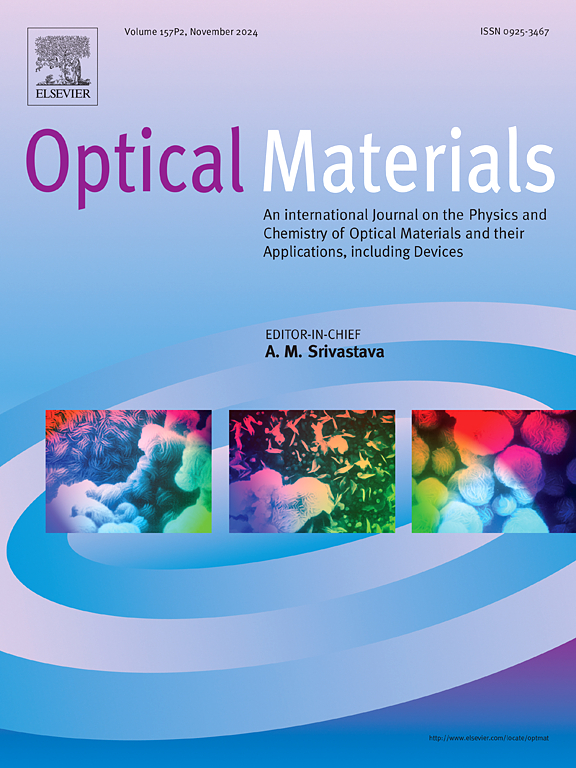Performance investigation and optimization of EDFL based on Lithium Niobate–Titanium Oxide nanomaterial saturable absorber
IF 3.8
3区 材料科学
Q2 MATERIALS SCIENCE, MULTIDISCIPLINARY
引用次数: 0
Abstract
In this research, we present an investigation of influence of output coupling ratio on the performance of a Q-switched erbium-doped fiber laser (EDFL). A new hybrid substance of a vinylidene fluoride-trifluoethylene P(VDF-TrFE) polymer with Lithium Niobate–Titanium Oxide nanomaterial [(Li1.075Nb0.625Ti0.45O3) to form, (P(VDF-TrFE)-LNTO) nanocomposite has been potentially worked as a saturable absorber (SA) in a Q-switched EDFL system at 1.55 μm region. This SA solid layer is successfully built using the drop-casting method to modulate cavity loss. The Q-switched process clearly performs consistently through reaching a remarkable signal-to-noise ratio (SNR) of 58 dB with output coupling ratio of 10:90. The pulses are built inside the laser cavity so that they would work efficiently with pump powers between 81 mW and 167 mW. The output power is between 1.96 mW and 4.07 mW, with 2.45 % slope efficiency. The laser cavity is operated at 1565.5 nm wavelength with a pulsing rate between 110.3 and 139.9 kHz and pulse width ranged from 3.32 to 1.98 μs. The results of our investigation indicate that a higher repetition rate with multi-wavelength laser pulses can be obtained with 50:50 OC. In contrast, the laser cavity with 90:10 OC achieves a narrower pulse width. Additionally, the experimental findings demonstrate that LNTO nanomaterial serves as a promising SA for development of Q-switched fiber lasers.
基于铌酸锂-氧化钛纳米材料的EDFL饱和吸收体性能研究与优化
本文研究了输出耦合比对调q掺铒光纤激光器(EDFL)性能的影响。在1.55 μm波段的调q EDFL系统中,用一种新型的偏氟乙烯-三氟乙烯P(VDF-TrFE)聚合物与铌酸锂-氧化钛纳米材料[(Li1.075Nb0.625Ti0.45O3)形成了P(VDF-TrFE)-LNTO纳米复合材料。采用滴铸法成功地构建了该SA固体层,以调节空腔损耗。调q过程通过达到58 dB的显着信噪比(SNR)和10:90的输出耦合比,明显表现出一致性。这些脉冲被放置在激光腔内,这样它们就可以在81兆瓦到167兆瓦之间的泵浦功率下有效地工作。输出功率在1.96 ~ 4.07 mW之间,斜率效率为2.45%。激光腔的工作波长为1565.5 nm,脉冲速率为110.3 ~ 139.9 kHz,脉宽为3.32 ~ 1.98 μs。研究结果表明,当温度为50:50时,多波长激光脉冲具有较高的重复率。相比之下,90:10 OC的激光腔实现了更窄的脉冲宽度。此外,实验结果表明,LNTO纳米材料在调q光纤激光器的发展中具有良好的应用前景。
本文章由计算机程序翻译,如有差异,请以英文原文为准。
求助全文
约1分钟内获得全文
求助全文
来源期刊

Optical Materials
工程技术-材料科学:综合
CiteScore
6.60
自引率
12.80%
发文量
1265
审稿时长
38 days
期刊介绍:
Optical Materials has an open access mirror journal Optical Materials: X, sharing the same aims and scope, editorial team, submission system and rigorous peer review.
The purpose of Optical Materials is to provide a means of communication and technology transfer between researchers who are interested in materials for potential device applications. The journal publishes original papers and review articles on the design, synthesis, characterisation and applications of optical materials.
OPTICAL MATERIALS focuses on:
• Optical Properties of Material Systems;
• The Materials Aspects of Optical Phenomena;
• The Materials Aspects of Devices and Applications.
Authors can submit separate research elements describing their data to Data in Brief and methods to Methods X.
 求助内容:
求助内容: 应助结果提醒方式:
应助结果提醒方式:


